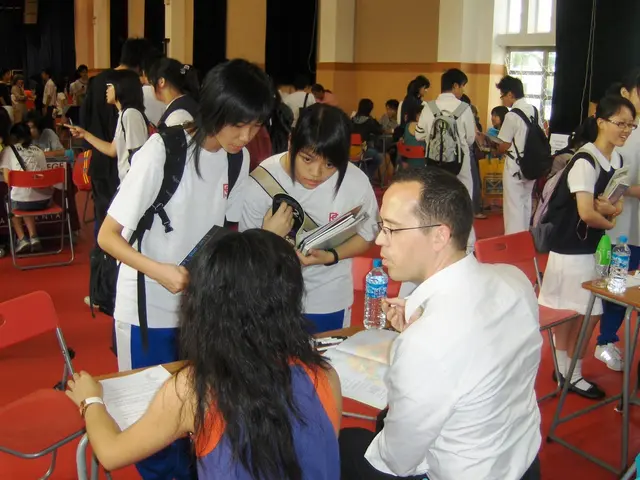Trump Advances AI Integration Proposal for K-12 Schools via New Draft Executive Order
Schools in the USA often wrestle with financing essentials like pencils and paper, while the new education secretary is attempting to uphold President Trump's promise of minimizing federal intervention in education, except to defund universities that infringe on free speech rights.
On a different note, a prospective executive order centers around integrating AI into classrooms. Named "Advancing artificial intelligence education for American youth," the order seeks to propel AI into the educational landscape by funneling federal funds towards cultivating "AI literacy" skills among students and educators.
The order underscores that AI is "revolutionizing industries, increasing productivity, and altering the way we live and work." The aim is to keep the United States at the forefront of technological advancement by arming the nation's youth with the necessary skills to harness and create the next generation of AI technology.
The Trump administration may be responding directly to China's recent announcement to revamp classrooms by weaving AI applications into textbooks and the curriculum. These two countries are locked in fierce competition, hoping to retain a lead in the artificial intelligence sector to safeguard their global influence. China, aiming to displace the USA as the leading global hegemon, is at the center of this race.
If this executive order comes to fruition, a White House task force on AI education will be established, featuring members from the technology sector, such as Michael Kratsios, director of the Office of Science and Technology Policy, and Trump's advisor on crypto and AI, David Sacks.
The Washington Post shared some insights about the U.S. executive order: The order will prompt federal agencies to forge alliances with industry, academia, and nonprofit organizations to teach students "foundational AI literacy and critical thinking skills." The task force will comb through existing federal funding, such as grants, to fund AI programs, and federal agencies will prioritize spending on AI education, the draft order suggests.
Education Secretary Linda McMahon will prioritize federal grant funding for training teachers on how to integrate AI into their teaching, including administrative work, teacher training, and evaluation. All educators will be required to undergo professional development to integrate AI into every subject area, says the draft order.
It is ironic that 'AI' and 'critical thinking' share the same sentence, as they are counterproductive.
A study by Microsoft and Carnegie Mellon University found that those who trusted AI assistants the most thought less critically about their conclusions. This trend is concerning, as experts have warned that novice programmers often accept AI-generated answers without fully understanding the code. This lack of fundamental knowledge could hinder problem-solving and debugging abilities. On platforms like X, users have even relied on chatbots to provide counterarguments in debates without verifying the factual accuracy of the information shared.
The potential benefits of AI in education are undeniable, such as swiftly searching through vast amounts of data or translating old works into English. Some companies have even attempted to create AI tutors that generate personalized learning tracks for each student. However, the appropriateness and effective implementation of AI in school settings remain questionable. After all, many educators still struggle to grasp AI models fully, often attributing human-like qualities to them despite their essence being software algorithms. Teachers often find it difficult to keep students engaged, with some schools considering banning smartphone access during the day instead of utilizing them for productivity in the 21st century.
Nothing exemplifies the disconnect better than Education Secretary McMahon's recent embarrassment when she mistakenly confused artificial intelligence with "A1," the steak sauce. Best of luck implementing ChatGPT o4-mini!
Additional Insights:
- The suggested executive order seeks to enhance AI integration in education by establishing a White House task force on AI education.
- The task force would focus on developing public-private partnerships, prioritizing AI teacher training, and increasing student AI literacy and critical thinking skills.
- If implemented, the order could equip American youth with essential skills for the future workforce, stimulate innovation, and foster a culture of problem-solving.
- However, maintaining the expertise to effectively integrate AI into curricula and ensuring equitable access to AI education across different demographics could present challenges.
- The newly proposed executive order, named "Advancing artificial intelligence education for American youth," aims to integrate AI into classrooms, funneling federal funds towards AI literacy skills among students and educators.
- Education Secretary Linda McMahon will prioritize federal grant funding for training teachers on how to integrate AI into their teaching, including administrative work, teacher training, and evaluation, according to the draft order.
- A study by Microsoft and Carnegie Mellon University found that those who trusted AI assistants the most thought less critically about their conclusions, which is concerning as experts have warned that novice programmers often accept AI-generated answers without fully understanding the code.
- The suggested executive order seeks to enhance AI integration in education by establishing a White House task force on AI education, focusing on developing public-private partnerships, prioritizing AI teacher training, and increasing student AI literacy and critical thinking skills.





